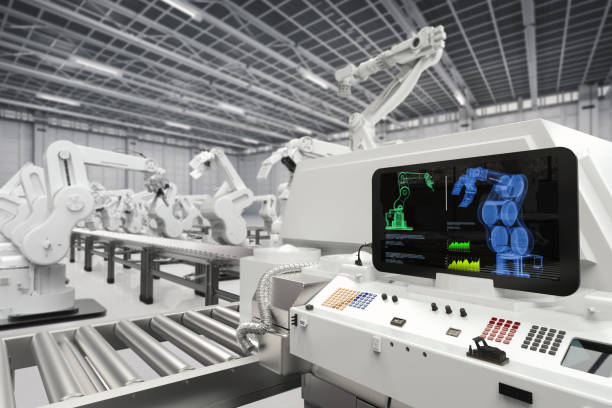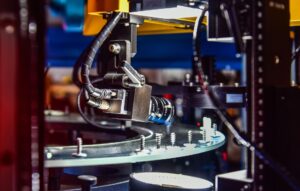3 Common Automation Solutions
in the Semiconductor Industry
The semiconductor industry has rapidly grown over the past few decades, becoming more complex and sophisticated, and automation has become an essential aspect of it. Automation helps semiconductor companies produce high-quality products quickly and efficiently, reducing the time required for various processes, increasing accuracy, and minimizing errors, while also reducing labor costs and improving worker safety. In this article, we explore three of the most common automation solutions available in the semiconductor industry.
Solution 1: Automated Test Equipment (ATE)

Automated Test Equipment (ATE) is a system used to test and measure semiconductor devices automatically. ATE is used to detect defects and ensure that semiconductor devices meet the required specifications. ATE systems are designed to test a wide range of semiconductor devices, including microprocessors, memory chips, and application-specific integrated circuits (ASICs).
Applications of ATE in the Semiconductor Industry
ATE systems are used in various applications in the semiconductor industry, including design verification, production testing, and failure analysis. ATE systems are also used to test semiconductor devices for automotive, aerospace, and military applications.
Benefits of ATE in the Semiconductor Industry
ATE systems can test a large number of semiconductor devices quickly and accurately, reducing the time required for testing. ATE systems can detect defects and ensure that semiconductor devices meet the required specifications, helping to improve product quality.
Solution 2: Manufacturing Execution System (MES)
Manufacturing Execution System (MES) is a software system used to manage and monitor the manufacturing process in real-time. MES systems help to improve the efficiency and productivity of the manufacturing process by providing real-time visibility into the production process. MES systems are used to manage and control various aspects of the manufacturing process, including scheduling, inventory management, and quality control.
Applications of MES in the Semiconductor Industry
MES systems are used in various applications in the semiconductor industry, including production scheduling, inventory management, and quality control. MES systems are also used to manage and control the production of semiconductor devices, including wafer fabrication, assembly, and testing.
Benefits of MES in the Semiconductor Industry
MES systems provide real-time visibility into the manufacturing process, which helps to identify and resolve issues quickly. MES systems also help to reduce the time required for various processes.
Solution 3: Robotics

Robotics is the use of machines to perform tasks that would normally be done by humans. In the semiconductor industry, robotics is used to perform various tasks, including wafer handling, die sorting, and packaging.
Applications of Robotics in the Semiconductor Industry
Robotics is used in various applications in the semiconductor industry, including wafer handling, die sorting, packaging, and assembly. Robotics is also used in the development and manufacturing of equipment used in the semiconductor industry.
Benefits of Robotics in the Semiconductor Industry
Robots can perform tasks quickly and accurately, reducing the time required
for various processes. Robotics also helps to reduce labor costs and improve the safety of workers by minimizing the need for human intervention. Robots can operate in harsh environments, which makes them ideal for use in the semiconductor industry.
for various processes. Robotics also helps to reduce labor costs and improve the safety of workers by minimizing the need for human intervention. Robots can operate in harsh environments, which makes them ideal for use in the semiconductor industry.
Conclusion
The semiconductor industry depends on automation solutions like Automated Test Equipment (ATE), Manufacturing Execution System (MES), and robotics to increase productivity, efficiency, and accuracy. These solutions work together to optimize the manufacturing process and help produce high-quality products quickly and efficiently. Without automation, the industry would struggle to keep up with the high demands for semiconductor devices, and quality control would be much harder to achieve. Therefore, as with all manufacturing industries, automation is critical to the success and growth of the semiconductor industry.
Semiconductor Automation FAQs
What is semiconductor automation?
Semiconductor automation refers to the use of advanced technologies and equipment to automate the semiconductor manufacturing process.
What are the benefits of semiconductor automation?
Semiconductor automation helps to increase productivity, efficiency, and accuracy, while also reducing labor costs and improving worker safety.
What are some other examples of semiconductor automation solutions?
Besides ATE, MES, and robotics, other examples of semiconductor automation solutions include computer-aided design (CAD), statistical process control (SPC), and automated material handling systems.
What are the difficulties encountered in semiconductor automation?
Obstacles in semiconductor automation can include integration with existing equipment and systems, as well as the potential requirement for skilled personnel to operate and maintain the equipment.
What are the future trends in semiconductor automation?
Future trends in semiconductor automation include the use of artificial intelligence (AI), machine learning (ML), and the Internet of Things (IoT) to further optimize and automate the manufacturing process.



